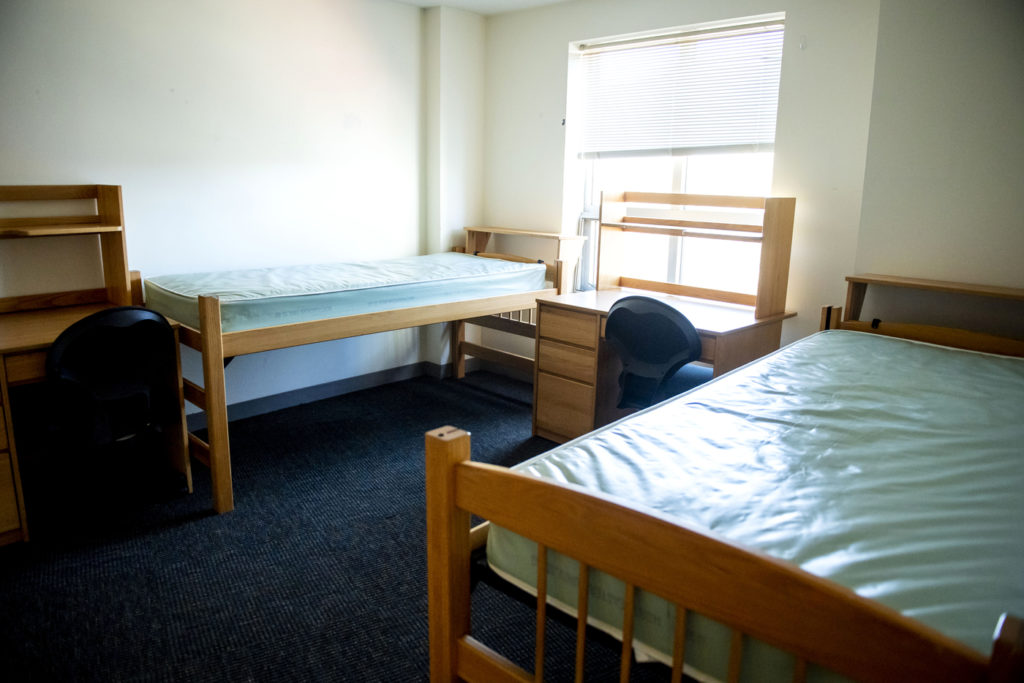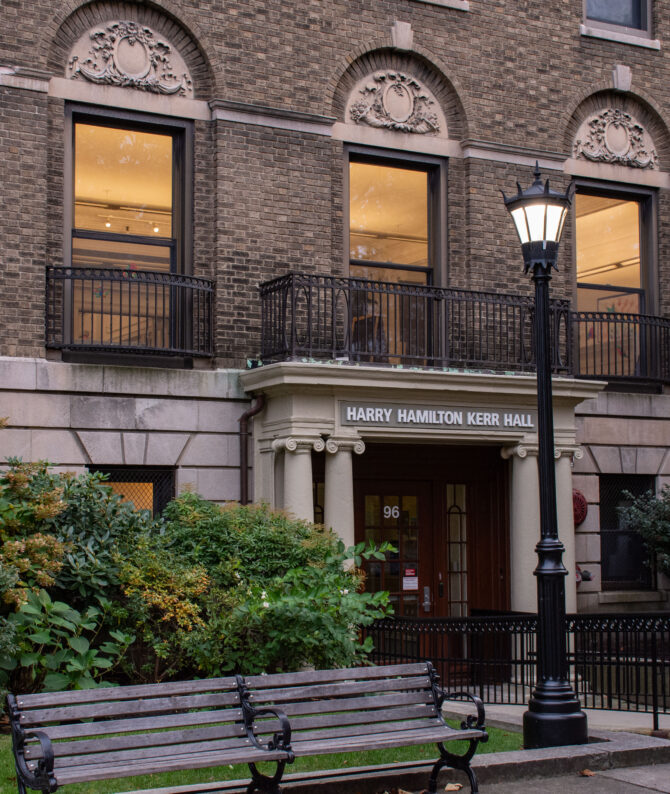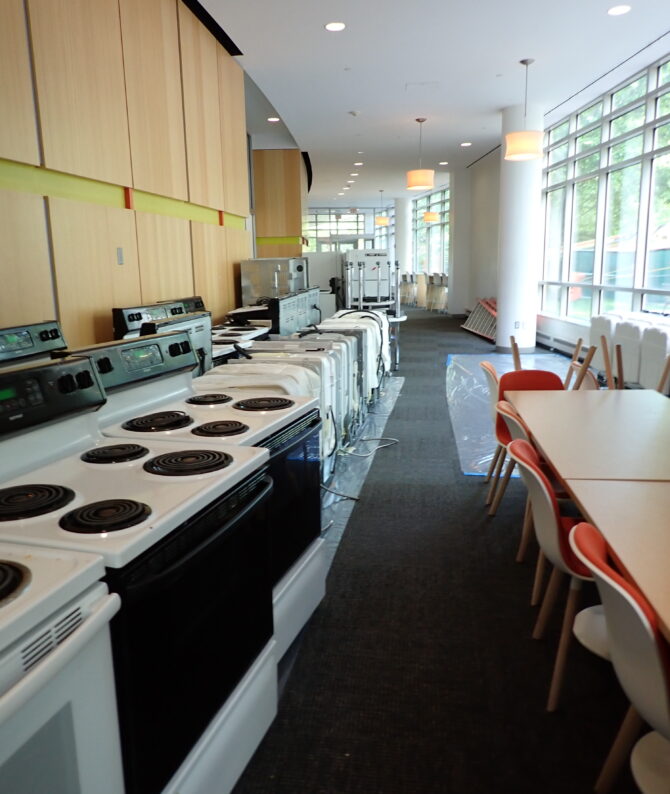What to Do About Waste: The Trash Takedown and Waste Ban Breakdown

This November, the Massachusetts Department of Environmental Protection (MassDEP) expanded its waste disposal bans to include mattresses, textiles, and a lower threshold on businesses that are required to divert food waste. These join a growing list of existing materials currently banned from disposal in Massachusetts, all of which Northeastern must comply with when managing its own waste.
At Northeastern, mattress recycling and the diversion of food waste are already in practice. There may be room to further improve the efficiency of these systems, but the biggest change for the university comes with the textile waste ban. The university is working to provide new ways for our community to recycle and donate textiles in compliance with the new mandate.
Gretchen Carey, president of the statewide nonprofit MassRecycle and outreach/education coordinator for the waste collection company Republic Services, is quite familiar with this work. “Waste bans include things you probably wouldn’t be surprised at, like bottles, cans, paper, cardboard, [and] glass bottles,” she explains. But it also includes materials you might not typically think about, like yard waste, metal, construction and demolition waste, large appliances, and more.
“These are all things that you see picked up separately,” says Carey.
The idea first took shape in the 1990s. “MassDEP realized that we were running out of landfill space severely, and therefore, came up with what they call ‘waste bans’,” Carey explains.
Waste bans, as the name implies, place restrictions upon the types of items that can be disposed, transferred for disposal, or contracted for disposal at solid waste facilities. These banned items, including certain hazardous items and recyclable materials, must be put toward a future use instead of entering a landfill.
According to the MassDEP, waste bans “help us capture valuable resources, save energy, reduce greenhouse gas emissions, and lessen our reliance on landfills and incinerators.”
Waste bans also apply to everyone, from households to businesses to municipalities. Carey works to ensure different entities are able to comply with waste ban standards. “It’s my job to make the whole [process] smoother and be available to help if anyone needs training for their staff, tenants, residents, you name it. Whoever it is that needs to get on board, that’s where I help out,” she explains.
And in general, Carey says people take the waste bans pretty seriously.
When a banned item is improperly disposed of – what Carey refers to as a “failed load” – MassDEP first sends a warning letter to the party in question. If the problem persists in the future, MassDEP can issue a $1,000 fine for each instance of failure.
How Northeastern complies with the new waste bans.
Sue Higgins, Associate Director of Materials and Recycling at Northeastern University, describes how Northeastern is working to comply with the latest waste ban restrictions.
 |
 |
1) Reduced threshold on facilities that are required to divert food wasteThis had less of an impact on the university, as Northeastern was already acting in compliance with the previous, less restrictive ban. “We generate 10 tons of food waste a week,” says Higgins. The previous food waste ban placed a restriction on facilities generating more than one ton of material per week. And on November 1st, the threshold was lowered to a one-half ton of material per week. “I think that in the future, we can anticipate that next steps might be to expand the ban to residential spaces,” says Higgins. “But we’re already ahead of that. We’re already doing our part, starting with a composting pilot in East Village that is going very well. I’m optimistic that we’ll be able to add one or more residence halls next year, assuming the pilot continues to perform strongly.” Higgins further explains, “We’re continuously working to strengthen our food waste composting program. If the state does tighten the food waste ban further, or make it applicable to residential locations, we’ll be prepared.” |
2) Restriction on the disposal of mattresses“Northeastern has already been recycling its mattresses for more than five years,” says Higgins. The university may have to plan their mattress pickups further in advance, as there will be greater demand for mattress recycling services across the state, but ultimately the ban does not pose significant changes to Northeastern’s current practices. |
3) Textile waste banThis was the mandate that presented the greatest number and diversity of opportunities for new initiatives on campus. Northeastern’s Materials & Recycling department is in the process of creating a year-round, readily-available program that will allow students, faculty, and staff within the Northeastern community to drop off their textile materials for recycling. For example, “the majority of textiles comes from residence halls, so we are working with ResLife staff to evaluate potential options for placing collection bins there,” Higgins explains. “We have to find a system that is convenient to students, but also operationally viable.” While this process is underway, Higgins and the Facilities staff continue to support and help facilitate student-led collection initiatives as well, such as Trash2Treasure’s (T2T) yearly collection events. Facilities provides hampers, bags, and even scales to record the total weight of textile material collected at these events. For larger volumes of textiles, Facilities has also helped to arrange pickup by a textile recycler. In May 2022, following a very successful collection event by T2T, 1.9 tons of clothing, bedding, linens, and other textiles were diverted to reuse and recycling opportunities. Higgins also notes there are plenty of drop-off bins throughout the city where students can bring their textile materials. |
Complying with the new waste bans at home
For members of the Northeastern community who are wondering how to comply with these new waste bans at home, Higgins says, “the best advice for textiles is to donate to the highest and best uses.”
This may include charitable organizations within your community, small local business consignment shops, or even thrifting platforms like ThredUp or Poshmark. “Many communities also have drop-off bins in collaboration with public schools,” says Higgins. “Schools can earn money back on those donations on the order of tens of thousands of dollars a year.”
Mattresses can present a challenge for individual households, but Higgins emphasizes that the best method will likely depend on the resources available within your community, which requires doing a bit of research. “Every community is handling the mattress ban differently,” she says. “Some communities will require that you bring your mattress to their facility. Others may have a curbside collection program, which could be fee-based.”
 |
Carey also provides informational resources and opportunities to help educate the public about waste bans and the importance of recycling, which gives products like mattresses and textiles a second life. This often includes working with schools and universities like Northeastern. She was recently at the Sustainability and Bike Fair, where she challenged students to identify the second-life items that may come from a product after its first life is complete.
“Approximately 80 to 85% of what gets put in a recycling bin gets used for a second life,” Carey adds.
Carey also emphasizes why we, as consumers, should buy second-life products made from recycled materials. “The way I look at it is, if you put it in the bin, I take away the bin, I sort it out, I make bales out of the material, and then I sell it to someone. And if you buy [the second life recycled product], you close the loop,” Carey explains. “If you don’t buy it, and if no one buys it, the manufacturer has no reason to make it, which means he has no reason to buy my bales, and the whole thing comes undone.”
As president of the nonprofit MassRecycle, Carey works to advance three core pillars: connection, education, and advocacy. She reflects upon her experiences within the field. “Everybody at the table wants the best possible outcome,” she says. “We are all working together to make the environment a healthier place, to make less waste, to do the best thing possible, to do good. And it is an incredibly collaborative group of people. You come for the mission, but at the same time you stay for the people.”
 |
Higgins is in the process of collaborating with Carey to form a new recycling committee with other colleges and universities in the Boston area, to further this mission. She elaborated, “The purpose is to establish and grow a beneficial relationship between facilities and sustainability staff that are responsible for managing campus waste and recycling, with the intent of collectively advancing and improving programs.” There has been a favorable response from many area institutions, including BU, BC, Tufts, Harvard, UMass, MIT, Brandeis, Endicott and Salem State. “I’m looking forward to working with these colleagues, to share our experiences and explore new opportunities we can bring to the Northeastern campus,” says Higgins.
“We’re very excited about this,” says Carey. “We’re going to be connecting people to share best practices, understand what works and what doesn’t work, the lessons learned, and vendor reviews because these vendors are a real resource and should be shared. And at the same time, any information about things that don’t work will save everybody that time.”
Looking to the future, Carey knows there is still much work to be done, particularly at the legislative level. But waste bans can play an integral role in facilitating meaningful change.
Higgins is supportive of the waste bans, which she notes have been implemented for items for which recycling infrastructure is available to readily sort and process the materials and secondary markets are established for future uses. She agrees with Carey that work is needed at the legislative level, including to facilitate extended producer responsibility (EPR) initiatives that shift end-of-life recycling responsibilities to manufacturers. In the interim, Higgins says “the Facilities Materials & Recycling Department will continue to put forth its best efforts to responsibly and effectively collect materials generated for recycling and composting, and we will continue to explore opportunities to reduce the amount of waste sent for disposal.”
Written by Daria Healey, November 15th, 2022



